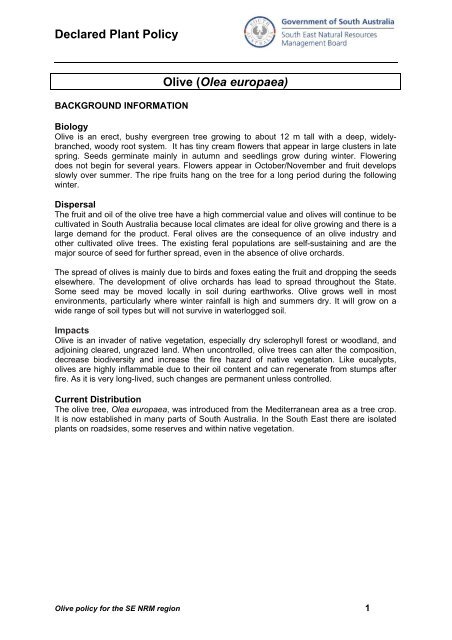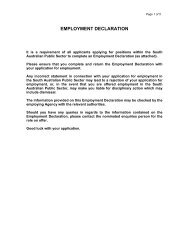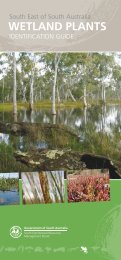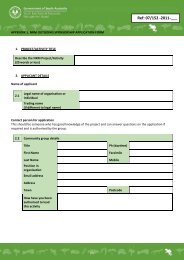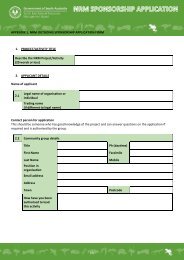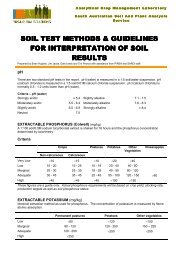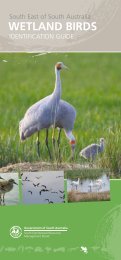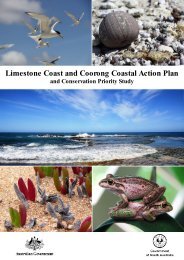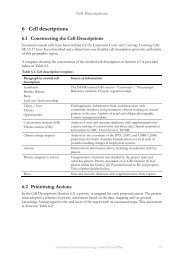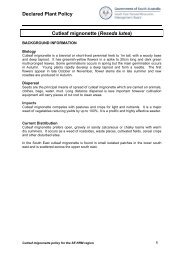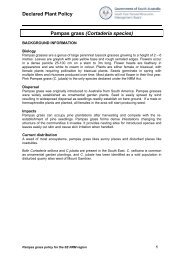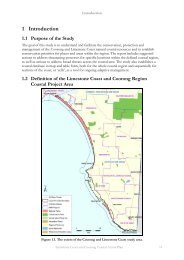Olive policy - South East Natural Resources Management Board ...
Olive policy - South East Natural Resources Management Board ...
Olive policy - South East Natural Resources Management Board ...
Create successful ePaper yourself
Turn your PDF publications into a flip-book with our unique Google optimized e-Paper software.
Declared Plant Policy<br />
BACKGROUND INFORMATION<br />
<strong>Olive</strong> (Olea europaea)<br />
Biology<br />
<strong>Olive</strong> is an erect, bushy evergreen tree growing to about 12 m tall with a deep, widelybranched,<br />
woody root system. It has tiny cream flowers that appear in large clusters in late<br />
spring. Seeds germinate mainly in autumn and seedlings grow during winter. Flowering<br />
does not begin for several years. Flowers appear in October/November and fruit develops<br />
slowly over summer. The ripe fruits hang on the tree for a long period during the following<br />
winter.<br />
Dispersal<br />
The fruit and oil of the olive tree have a high commercial value and olives will continue to be<br />
cultivated in <strong>South</strong> Australia because local climates are ideal for olive growing and there is a<br />
large demand for the product. Feral olives are the consequence of an olive industry and<br />
other cultivated olive trees. The existing feral populations are self-sustaining and are the<br />
major source of seed for further spread, even in the absence of olive orchards.<br />
The spread of olives is mainly due to birds and foxes eating the fruit and dropping the seeds<br />
elsewhere. The development of olive orchards has lead to spread throughout the State.<br />
Some seed may be moved locally in soil during earthworks. <strong>Olive</strong> grows well in most<br />
environments, particularly where winter rainfall is high and summers dry. It will grow on a<br />
wide range of soil types but will not survive in waterlogged soil.<br />
Impacts<br />
<strong>Olive</strong> is an invader of native vegetation, especially dry sclerophyll forest or woodland, and<br />
adjoining cleared, ungrazed land. When uncontrolled, olive trees can alter the composition,<br />
decrease biodiversity and increase the fire hazard of native vegetation. Like eucalypts,<br />
olives are highly inflammable due to their oil content and can regenerate from stumps after<br />
fire. As it is very long-lived, such changes are permanent unless controlled.<br />
Current Distribution<br />
The olive tree, Olea europaea, was introduced from the Mediterranean area as a tree crop.<br />
It is now established in many parts of <strong>South</strong> Australia. In the <strong>South</strong> <strong>East</strong> there are isolated<br />
plants on roadsides, some reserves and within native vegetation.<br />
<strong>Olive</strong> <strong>policy</strong> for the SE NRM region 1
Declared Plant Policy<br />
<strong>Olive</strong> <strong>policy</strong> for the SE NRM region 2
Declared Plant Policy<br />
REGIONAL PRIORITY<br />
<strong>Olive</strong> was assessed during the <strong>South</strong> <strong>East</strong> Weed Risk Assessment project. <strong>Olive</strong> is mainly a<br />
weed of native vegetation and was not considered important in the other landuses.<br />
<strong>Olive</strong> was not included in the top 15 agricultural weeds for the <strong>South</strong> <strong>East</strong>.<br />
The table below outlines the management actions required and relative priorities for olive in<br />
each landuse:<br />
<strong>Management</strong><br />
Action<br />
Relative<br />
priority<br />
Aquatic Crop/pasture Forestry Grazing Irrigated Native<br />
Vegetation<br />
Perennial<br />
Horticulture<br />
Urban<br />
N/A N/A N/A N/A N/A Manage N/A N/A<br />
Sites<br />
- - - - - 5 - -<br />
AIMS:<br />
1. To protect natural environments from the loss of biodiversity caused by olive.<br />
2. To protect the olive industry from pests and pathogens harboured by feral olive trees.<br />
3. To reduce the distribution of olive in the <strong>South</strong> <strong>East</strong>.<br />
OBJECTIVES:<br />
• Identification of the full extent of olive infestations in the <strong>South</strong> <strong>East</strong>.<br />
• Enforce control of olive infestations on roadsides and unused plantations to prevent<br />
spread to other areas.<br />
• Identification of important sites to be protected from olive.<br />
• Increase awareness about the impacts of olive.<br />
IMPLEMENTATION<br />
State Level<br />
• Increase awareness about the impacts of olive on native vegetation.<br />
Regional Priority Actions for the SE NRM <strong>Board</strong><br />
• Authorised Officers to inspect, map and monitor all infestations of olives.<br />
• Control of olive enforced for isolated infestations and on roadsides.<br />
• Buffer zones enforced around all plantations of olive.<br />
• Seek external funding for projects relating to olive control which will protect natural<br />
environments.<br />
• Provide risk assessment input to Local Government planning procedures regarding<br />
approval for new olive plantations.<br />
<strong>Olive</strong> <strong>policy</strong> for the SE NRM region 3
Declared Plant Policy<br />
Local action<br />
• All landholders to implement active control programs according to seasonal<br />
conditions and the instructions of the Authorised Officer.<br />
DECLARATIONS<br />
The following sections of the NRM Act apply to olives (that are not planted and maintained<br />
for domestic or commercial use) in all Local Government areas in the <strong>South</strong> <strong>East</strong> NRM<br />
region:<br />
182 (2)<br />
(3)<br />
Land owner must control the plant on their land<br />
Land owner must take prescribed measures for the control of<br />
the plant on their land<br />
185 (1) NRM authority may recover costs for control of weeds on<br />
roadsides from adjoining land owners<br />
Implementation<br />
Responsibility of Operations Manager<br />
Periodic Review<br />
Responsibility of Operations Manager<br />
Date endorsed by the SENRMB 24 May 2006<br />
Date scheduled for review 2011<br />
Version Date Version Reference Sections Description of Changes<br />
May 2006 1 Whole document Endorsed By SENRM <strong>Board</strong><br />
Released to public<br />
March 2011 2 Whole document Review and update of distribution maps<br />
<strong>Olive</strong> <strong>policy</strong> for the SE NRM region 4


